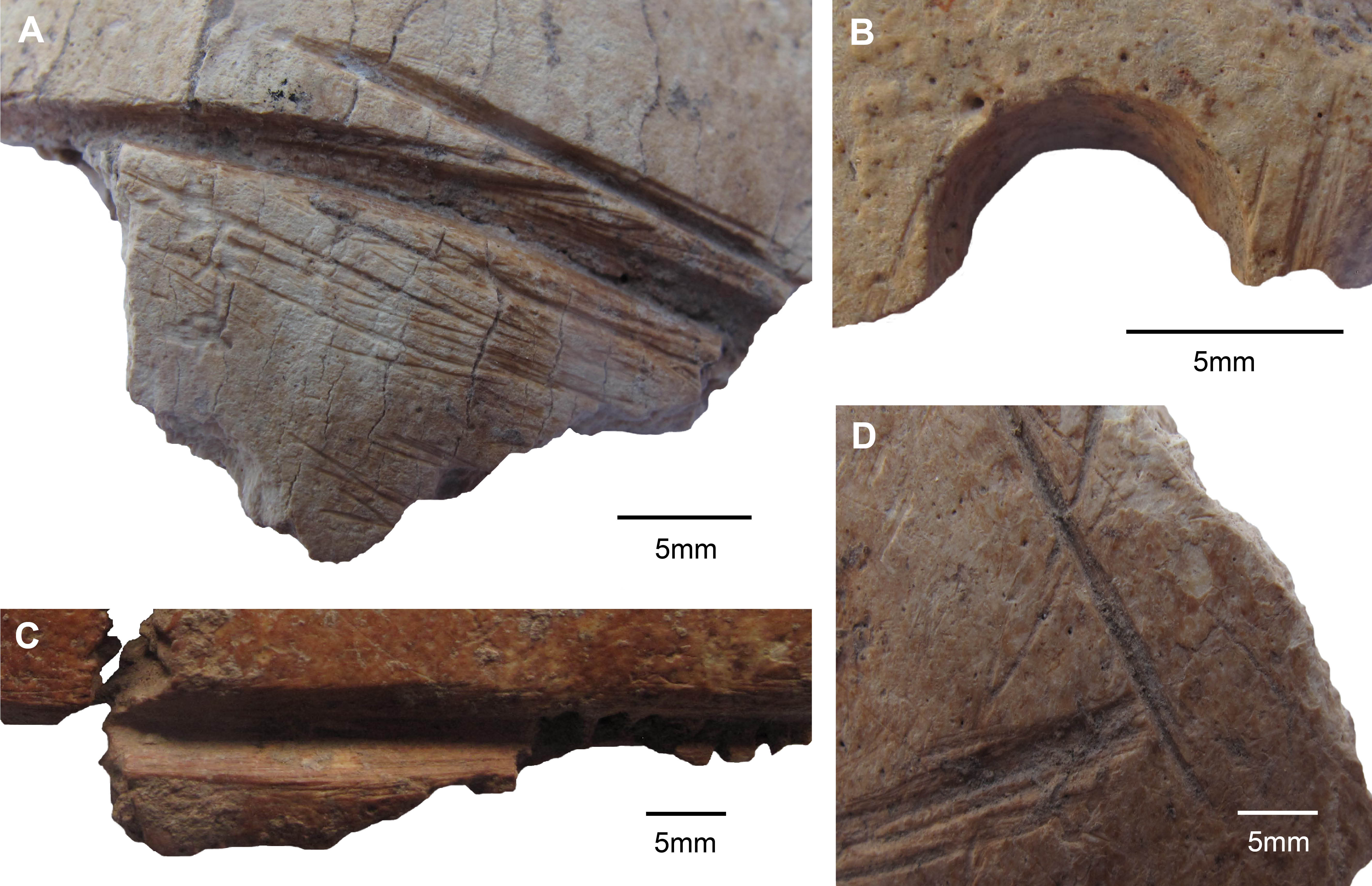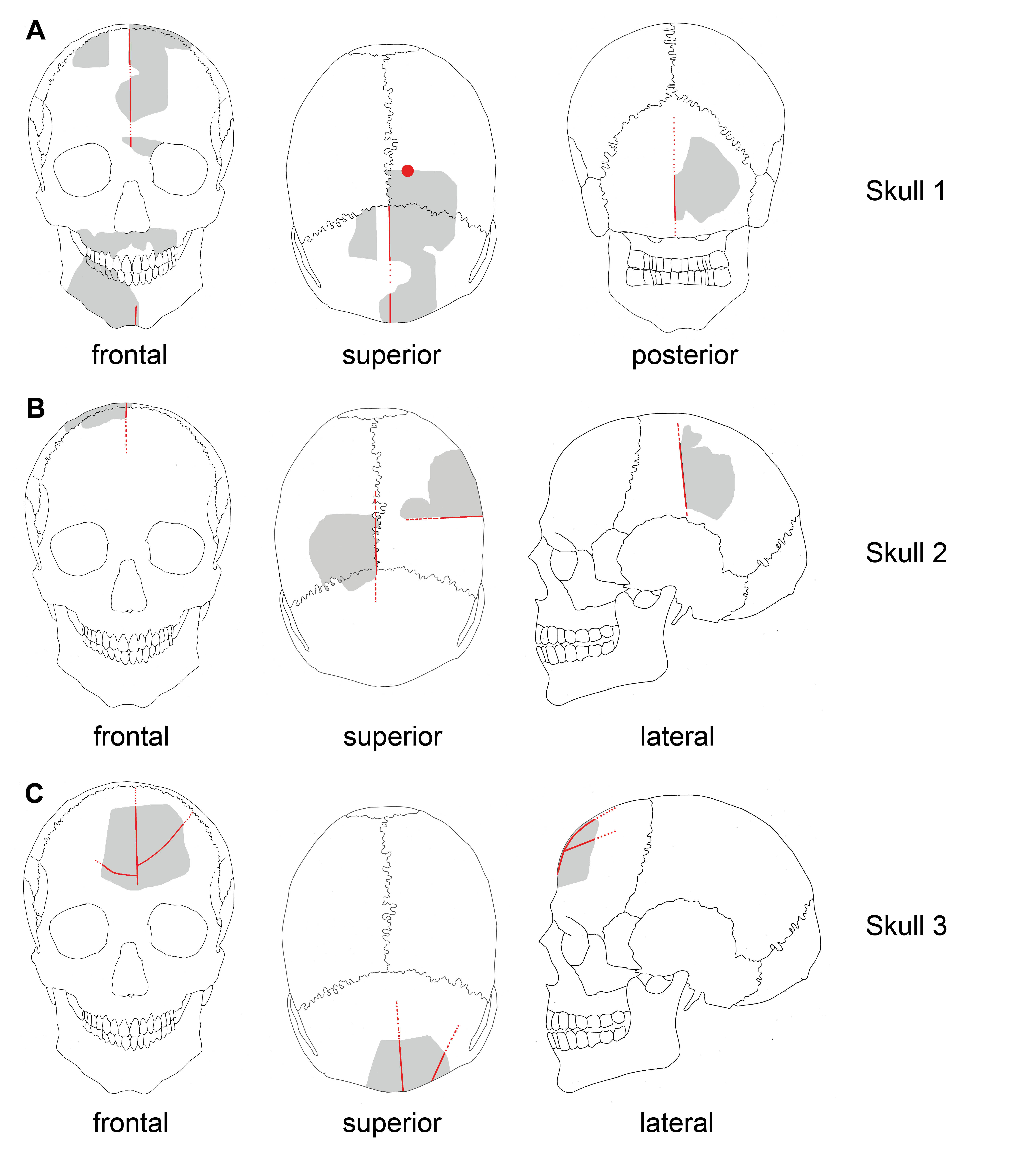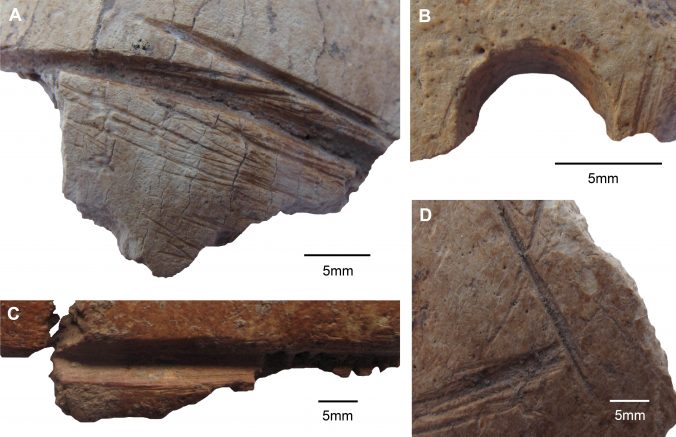Although burials are still not known at Göbekli Tepe, in recent years a total of 700 human bone fragments have been recovered from the fill of prehistoric buildings and adjacent areas. Anthropological analysis of this material by J. Gresky and J. Haelm from the Natural Science Department of the German Archaeological Institute is now beginning to reveal intimate details about the Early Neolithic populations at the site. Especially the fragments of three human skulls are shedding light on the treatment of the dead, which is suggestive of a previously unknown form of skull cult.

Macroscopic details of artificial skull modifications. A, C, D: carvings, B: drilled perforation. (Image: Gresky, DAI)
Deep grooves – made using flint tools – were carved into the surface of the skulls. In the best preserved cranium these carvings were accompanied by a carefully placed perforation (drilled hole). Modifications were essential for the purpose of decorating and displaying the human skulls. In this context, it can even be argued that the drilled perforation was used to suspend the cranium from a post or the beam of a building (perhaps even from a T-shaped pillar)!

Schematic drawings of Göbekli Tepe skulls. Gray: preserved elements; red: modifications. (Image: Gresky, Haelm, DAI)
- The research article J. Gresky, J. Haelm, L. Clare, “Modified human crania from Göbekli Tepe provide evidence for a new form of Neolithic skull cult” is published in Science Advances: DOI: 10.1126/sciadv.1700564, published 28 June 2017, Sci. Adv. 3, e1700564 (2017): http://advances.sciencemag.org/content/3/6/e1700564
- Also check out the contribution by Andrew Curry at sciencemag.org: http://www.sciencemag.org/news/2017/06/carved-human-skulls-found-ancient-stone-temple
Further information
- Department of Natural Sciences, Prehistoric Anthropology at the DAI: http://www.dainst.org/standort/95515
- Project page: Anthropology at Göbekli Tepe: http://www.dainst.org/projekt/-/project-display/2048601

Reblogged this on Voices and Visions.
Reblogged this on tabletkitabesi.
Interesting find.
1. could be modifications to position the skull (eg so it could be displayed by hanging) [as stated above]
2. could be modifications to add something to the skull eg a wig or head dress or something else.
3. could have some other purpose eg to let the “spirits out”, other
4. to permit ingress of something – cant think what and so tend to exclude that.
These are skull fragments rather than whole skulls and so that complicates matters as well
Just some thoughts passing on.
cheers and keep up the good work.
OB
Thanks, Owen. Of course, it would be so much easier if we could work on completely preserved skulls and skeletons. Nevertheless the fragments of skull that we do have certainly suggest your first two points.
The drill hole in the best preserved skull was made after death and is too small to be a trepanation (I think this may be the direction you’re going here).
Interesting find indeed. I could add some possible uses for the skulls.
1. They had deep cisterns with water. A human skull can be used for fetching the water. That could be a part of initiation process for young warriors, for them to learn the wisdom of the dead by drinking water from their skulls.
2. One can put a candle inside and create some eerie atmosphere in a way that the Americans still do with pumpkins on the day of the dead. In a ritual centre that presumably operated at night, one could use candles, and could have utilized such an addition to the scenery.
3. It was a custom at that time to display prominently the heads of dead enemies for mockery. This is why they never depicted faces on T-pillars. If more so treated heads are to be found, than this could be the answer.
4. If the number of so treated skulls is only 3, then they were part of the ritual. One skull for the Boar, one for the Fox, and one for the Bull, all connected by a rope, representing the Serpent.
My questions are:
a. Can the skulls be dated ?
b. Can DNA be extracted from them ?
Interesting suggestions.. Always fun to speculate.
Cocerning your questions:
1) The skulls can be assigned to the Pre-Pottery Neolithic A (PPNA) and/or Early/Middle Pre-Pottery Neolithic B (EPPNB/MPPNB) periods (9500-8000 BC). Unfortunately, we cannot be more presise than that because the fragments were found in fill material, the origin and age of which cannot be determined. Also, radiocarbon ages made on the skull fragments were unsuccessful due to poor preservation.
2) For the same reason (poor preservation of collagen) it is extremely unlikely (impossible) that DNA is preserved.
Presume there was no pattern to where the skull fragments were found? Were they contemporaneous with the backfilling of GT? Any evidence of deliberate smashing? And is there any chance of DNA testing? Thanks in advance.
That’s right, Robert. There is no spatial pattern to where the fragments were found.
I suggest that the skull fragments were not intentionally deposited but slipped into their respective find locations as a result of erosional processes at the site. As such, the skull fragments are – of course – older than the “erosional event” which led to their final deposition.
No, there are no indications of deliberate smashing.
Concerning DNA, please refer to one of my previous answers.
Thanks for your interest.
Thanks, Lee. Missed the info on DNA.
Due to poor preservation of collagen in bones from the site it is extremely unlikely that DNA is preserved
Hi Lee,
In the longer Science Advances version you mention the backfill may not have arisen from intentional burial but rather from collapse of adjacent structures. Please could you expand on this and any other clues to the origin of the backfill..
best,
STEF
Hi Stef, I apologise for the late reply. Yes, in numerous papers it was stated that the monumental buildings at Göbekli Tepe were intentionally backfilled at the close of their use-lives, i.e. comparable to the “burial” of the human dead. Although this hypothesis has many supporters, it even being mentioned as one of the characteristics of so called “special” or “cult” buildings in the Pre-Pottery Neolitic, I believe that that alternative explanations should be considered. As the low-lying hollows at Göbekli Tepe (this is where most of the monumental round-oval buildings are found) have a very obvious catchment for rubble (i.e. remains of buildings located on adjacent higher parts of the mound) it cannot yet be ruled out that this was (at least the partial) source of the fill.
Hi Lee,
Tks for your reply. Please could you explain that hypothesis for a single enclosure e.g. D. How many buildings above it on the mound would be required to fall in and completely cover it and preserve it (5-10 by volume?). Would higher buildings need to have been broken down first into the chipped pieces of limestone (the rubble)?
I’ve read at least one paper which suggests the enclosures are younger and that older feasting and rubble from earlier parts of the mound might explain the carbon dating but I didn’t really find that convincing. Is it your view that the science indicates enclosure D was constructed 9600-9500BC and buried 9250BC?
best,
STEF
Hi Stef,
this is a very interesting topic, especially as it brings with it some (potentially) controversial new ideas.
Let me get straight to the point. As I see it, I think we need to move away from an interpretation of Göbekli Tepe as a “purely” ritual site and consider some innovative new ideas and interpretations, many of which we’ve recently been discussing in the project:
1) GT was probably settled by a quasi-sedentary population
2) Alternative explanations (other than ritual backfill/burial) could explain the filling of the monumental buildings: Slope slip (erosion) from higher parts of the mound is a very likely alternative.
3) Therefore, the large amounts of animal bone found in the fill of the buildings could stem from eroded middens. Feasting in the context of “building burial” is not needed to explain the accumulations of animal bone.
4) The monumental buildings (A-D) were most certainly long-lived structures with multiple building phases (some of which were perhaps in use well into the EPPNB period). This also applies to Building D that you mention. Notably, this would render the current site chronology (Level III/PPNA; Level II/EPPNB) completely redundant. It’s time for an overhaul..
Don’t get me wrong: I still think that Göbekli Tepe was an important social (and ritual) hub for early aceramic Neolithic groups. There is no doubt about that! Nevertheless, I strongly believe that GT should be “brought back down to earth”.
We all know that the site is special, but we should never lose sight of its overall context and its place in a much larger network of equally important and impressive contemporaneous early Holocene sites.
Best wishes,
Lee
Tks Lee,
That’s very interesting. So you’re suggesting the site was a big campsite in the 10th millennium and the enclosures were built later.. if so, what’s you’re best guess for the dates of the construction of the older (D/C/B/A) enclosures? And which other sites are comparable (apart from a couple of glyphs at Catal Huyuk)?
best,
STEF
Hi Stef,
although I cannot put an age to the earliest phases of the monumental buildings, I suspect that the earliest structures of this type were erected at GT some time in the mid-to late 10th millennium BC (PPNA). As I mentioned, these buildings continued to be in use for long periods, apparently into the EPPNB (c. 8700-8200 BC).
I also suspect that people were already residing at the site at this time (PPNA), though at the moment it’s difficult to say whether this would have been in a permanent (sedentary) settlement or whether they would have spent time at the site on a more seasonal basis; I’m beginning to suspect the former.
If you want to get an impression of PPNA (domestic) architecture, take a look at such sites as Körtik Tepe, Gusir Höyük and Hasankeyf Höyük (located east of Urfa in the Tigris basin).
If your interested in learning more about other T-pillar sites, check out the sites of Karahan Tepe, Hamzan Tepe, to name just a couple..
Best wishes,
Lee
Tks Lee. I had misunderstood you and will check out available info on Gusir Höyük and Hasankeyf Höyük. Are you saying that the oldest phase (D/C/B/A) was still in use after 8800BC (I know the later buildings were)? And, also, is the ‘terminus ante quem’ date for enclosure D wrong or simply irrelevant (which I understand you are now saying might have been naturally inundated by rubbish above it, rather than an elaborate funerary complex.)?
You’re welcome!
Yes, that’s right. It would appear that later building phases of structures A-D were still in use after 8800 BC.
Which ‘terminus ante quem’ for Building D do you mean?
Tks Lee.. the ‘terminus ante quem’ carbon date I referred to was the late 9th millennium layer II date over D.. but what i actually meant to refer to was the filling date of enclosure D – mid/late 10th millennium (KIA-44701) and asking whether that suggested the end of that enclosure’s use
Can they age the skull or bone if it is heavier than other bones on that time, others are saying ancient people have heavier bone due to high protein diet compare to grain diet maybe like reading the circular trees but in bones?.
i guess what i am also saying is that if there’s evidence of a particular date of the construction of enclosure D in the mid-10th millennium and you are suggesting the filling was not deliberate but a sudden inundation from an earlier ‘rubbish’ dump fall in, then, if some of that filling came from a couple of centuries later, then deliberate or not, that would end the use of that enclosure